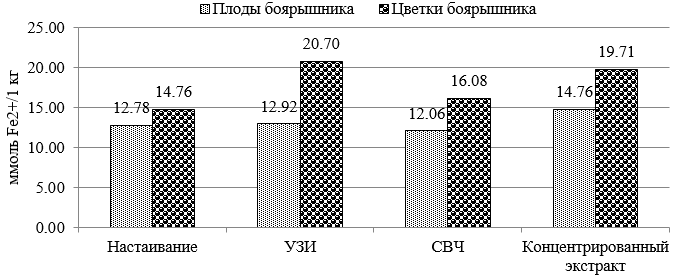COMPARATIVE CHARACTERISTICS OF THE INFLUENCE OF TECHNOLOGY OF EXTRACTION ON ANTIOXI-DANT PROPERTIES FOR THE FARRY AND FLOWERS OF THE TENDER (CRATAEGUS)
UDC 663.031
Abstract
The purpose of this work is to determine the most optimal method for extracting hawthorn fruits and flowers (Crataegus) with antioxidant properties. Flowers hawthorn rich in chemicals (choline, essential oil, acetylcholine, trimethylamine, flavone glycosides, caffeic, chlorogenic, ursolic and other various acids) and hawthorn fruit consist of fatty oil, triterpene saponins, choline, acetylcholine, tannins, sorbitol and organic acids. In order to determine the most optimal method for extracting a complex of substances with antioxidant properties from hawthorn fruit and flower extracts, the content of dry substances, phenols, flavonoids was studied, and antioxidant activity was determined using two methods: by trapping free radicals and by using the FRAP (restoring force) method. By all indicators (the content of dry substances, phenols, flavonoids, antioxidant activity), studied in the work, hawthorn flowers had high values. In this work, three extraction technologies were used: traditional – infusion (37 °С, 2 h), and innovative – using microwave (800 W, 1 min) and ultrasonic irradiation (0.5 W, 2 h). Of all the types of extraction considered, the most efficient and effective, according to the results of experiments, is extraction using ultrasonic radiation.
Downloads
Metrics
References
Jie W., Xingjiang X., Bo F. Hindawi, 2013, article 149363. DOI: 10.1155/2013/149363.
Emilie S., Stephen D. Am. Family Phys., 2010, vol. 81, no. 4, pp. 465–468.
Engels G., Brinckmann J. Am. Botan. Council, 2012, no. 96, pp. 1–6. DOI: 10.1007/s00606-004-0228-x.
Lakshmi T., Geetha R.V., Anitha R. Inter. J. Pharm. Tech. Res., 2012, vol. 4, no. 1, pp. 458–465. DOI: 10.1007/s11738-014-1769-4.
Pittler M.H., Schmidt K. Alternative Med. Rev., 2010, vol. 15, no. 2, pp. 164–167.
Kumar D., Arya V., Bhat Z.A., Khan N.A., Prasad D.N. Braz. J. Pharm., 2012, vol. 22, no. 5, pp. 1187–1200. DOI: 10.3390/foods7050066.
Zeiner M., Juranović I.C., Mihajlov K.D., Stingeder G. Web of Conferences, 2013, no. 1, pp. 1–3. DOI: 10.1051/e3sconf/20130134003.
Alirezalu A., Salehi P., Ahmadi N., Sonboli A., Aceto S., Maleki H.H., Ayyari M. Int. J. Food Prop., 2018, vol. 21, no. 1, pp. 452–470. DOI: 10.1080/10942912.2018.1446146.
Jurikova T., Sochor J., Rop O., Mlcek J., Balla S., Szekeres L., Adam V., Kizek R. Molecules, 2012, no. 17, pp. 14490–14509. DOI: 10.3390/molecules171214490.
Ruiz-Rodríguez B.M., Ancos B., Sánchez-Moreno C., Fernández-Ruiz V., Sánchez-Mata M.C., Cámara M., Tardío J. Fruits, 2014, vol. 69, pp. 61–73. DOI: 10.1051/fruits/2013102.
Martínez-Rodríguez1 J.L., Reyes-Estrada1 C.A., Gutiérrez-Hernández1 R., López J.A. J. Pharm. and Phytotherapy, 2016, vol. 8, no. 11, pp. 193–202. DOI: 10.5897/JPP2016.0428.
Özyürek M., Bener M., Güçlü K., Dönmez A.A., Süzgeç-Selçuk S., Pırıldar S., Meriçli A.H., Apak R. Rec. Nat. Prod., 2012, vol. 6, no. 3, pp. 263–277. DOI: 10.25092/baunfbed.370594.
Zhang Y., Shen T., Liu S., Zhao J., Chen W., Wang H. Trop. J. Pharm. Res., 2014, vol. 13, no. 3, pp. 353–357. DOI: 10.4314/tjpr.v13i3.6.
Mitev D., Vlakhov E., Vlakhov T., Peshev D., Hristova-Avakumova N., Hadjimitova V. Bulg. J. Phys., 2016, no. 43, pp. 311–319.
Miguel M.G., Nunes S., Dandlen S.A., Cavaco A.M., Antunes M.D. Food Sci. and Techn. (Campinas), 2014, vol. 34, no. 1, pp. 16–23. DOI: 10.21275/ART20162371.
Figueroa L.A., Navarro L.B., Vera M.P., Petricevich V.L. Int. J. Pharm. and Pharmac. Sci., 2014, vol. 6, no. 5, pp. 497–502. DOI: 10.12691/ajfst-6-5-6.
Rabeta M.S., Lin S.P. Sans Malay., 2015, vol. 44, no. 2, pp. 275–280. DOI: 10.17576/jsm-2015-4402-16.
Freedes C., Montenegr G., Zoffoli J.P., Gómez M., Robert P. Chilean J. Agr. Res., 2012, vol. 72, no. 4, pp. 582–589.
Moharram H.A., Youssef M.M. Alex. J. Fd. Sci. & Technol., 2014, vol. 11, no. 1, pp. 31–42.
Mierziak J., Kostyn K., Kulma A. J. Molecules, 2014, no. 19, pp. 16240–16265. DOI: 10.3390/molecules191016240.
Kunwar A., Priyadarsini K.I. J. Med. Allied. Sci., 2011, no. 1(2), pp. 53–60.
Sugiyama R., Oguni K., Ohashi S. Phys. Pro., 2014, no. 58, pp. 282–285.

Copyright (c) 2020 Khimiia rastitel'nogo syr'ia (Chemistry of plant raw material)

This work is licensed under a Creative Commons Attribution 4.0 International License.

This work is licensed under a Creative Commons Attribution 4.0 International License.
The authors, which are published in this journal, agree to the following conditions:
1. Authors retain the copyright to the work and transfer to the journal the right of the first publication along with the work, at the same time licensing it under the terms of the Creative Commons Attribution License, which allows others to distribute this work with the obligatory indication of the authorship of this work and a link to the original publication in this journal .
2. The authors retain the right to enter into separate, additional contractual agreements for the non-exclusive distribution of the version of the work published by this journal (for example, to place it in the university depository or to publish it in a book), with reference to the original publication in this journal.
3. Authors are allowed to post their work on the Internet (for example, in a university repository or on their personal website) before and during the review process of this journal, as this may lead to a productive discussion, as well as more links to this published work.











